Related Research Articles
Jazz is a music genre that originated in the African-American communities of New Orleans, Louisiana, in the late 19th and early 20th centuries, with its roots in blues and ragtime. Since the 1920s Jazz Age, it has been recognized as a major form of musical expression in traditional and popular music. Jazz is characterized by swing and blue notes, complex chords, call and response vocals, polyrhythms and improvisation. Jazz has roots in European harmony and African rhythmic rituals.
Ragtime, also spelled rag-time or rag time, is a musical style that had its peak from the 1890s to 1910s. Its cardinal trait is its syncopated, or "ragged" rhythm. Ragtime was popularized during the early 20th century by composers such as Scott Joplin, James Scott and Joseph Lamb. Ragtime pieces are typically composed for and performed on piano, though the genre has been adapted for a variety of instruments and styles.
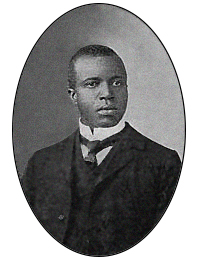
Scott Joplin was an American composer and pianist. Dubbed the "King of Ragtime", he composed more than 40 ragtime pieces, one ragtime ballet, and two operas. One of his first and most popular pieces, the "Maple Leaf Rag", became the genre's first and most influential hit, later being recognized as the quintessential rag. Joplin considered ragtime to be a form of classical music meant to be played in concert halls and largely disdained the performance of ragtime as honky tonk music most common in saloons.
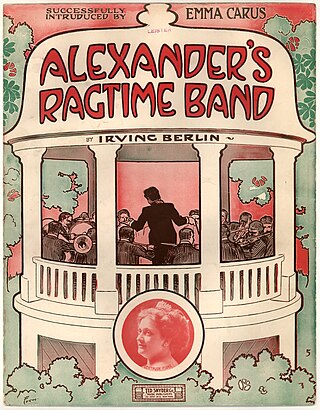
"Alexander's Ragtime Band" is a Tin Pan Alley song by American composer Irving Berlin released in 1911; it is often inaccurately cited as his first global hit. Despite its title, the song is a march as opposed to a rag and contains little syncopation. The song is a narrative sequel to Berlin's earlier 1910 composition "Alexander and His Clarinet". This earlier composition recounts the reconciliation between an African-American musician named Alexander Adams and his flame Eliza Johnson as well as highlights Alexander's innovative musical style. Berlin's friend Jack Alexander, a cornet-playing African-American bandleader, inspired the title character.

Ryland Peter Cooder is an American musician, songwriter, film score composer, record producer, and writer. He is a multi-instrumentalist but is best known for his slide guitar work, his interest in traditional music, and his collaborations with traditional musicians from many countries.

The cakewalk was a dance developed from the "prize walks" held in the mid-19th century, generally at get-togethers on Black slave plantations before and after emancipation in the Southern United States. Alternative names for the original form of the dance were "chalkline-walk", and the "walk-around". It was originally a processional partner dance performed with comical formality, and may have developed as a subtle mockery of the mannered dances of white slaveholders.
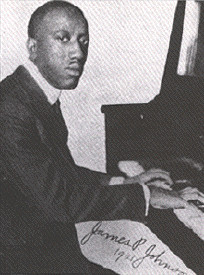
James Price Johnson was an American pianist and composer. A pioneer of stride piano, he was one of the most important pianists in the early era of recording, and like Jelly Roll Morton, one of the key figures in the evolution of ragtime into what was eventually called jazz. Johnson was a major influence on Count Basie, Duke Ellington, Art Tatum, Thelonious Monk, and Fats Waller, who was his student.
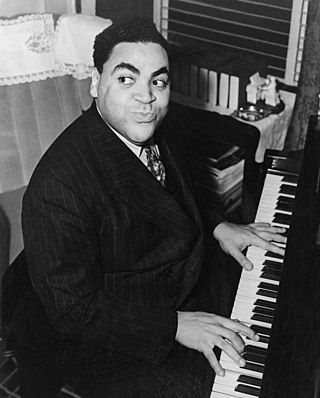
Stride jazz piano, often shortened to stride, is a jazz piano style that arose from ragtime players. Prominent stride pianists include James P. Johnson, Willie "the Lion" Smith, Fats Waller, Luckey Roberts, and Mary Lou Williams.
Charles Luckyth Roberts, better known as Luckey Roberts, was an American composer and stride pianist who worked in the jazz, ragtime, and blues styles. Roberts performed as musician, band/orchestra conductor, and dancer. He taught music and dance. He also owned a restaurant and bar in New York City and in Washington, D.C. Luckey Roberts noted compositions include "Junk Man Rag", "Moonlight Cocktail", "Pork and Beans" (1913), and "Railroad Blues".
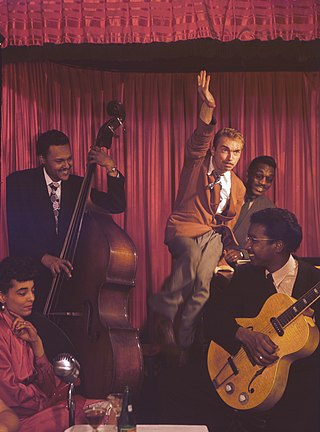
Harry "The Hipster" Gibson, born Harry Raab, was an American jazz pianist, singer, and songwriter. He played New York style stride piano and boogie woogie while singing in a wild, unrestrained style. His music career began in the late 1920s, when, under his real name, he played stride piano in Dixieland jazz bands in Harlem. He continued to perform there throughout the 1930s, adding the barrelhouse boogie of the time to his repertoire.

Henry St. Claire Fredericks Jr., better known by his stage name Taj Mahal, is an American blues musician. He plays the guitar, piano, banjo, harmonica, and many other instruments, often incorporating elements of world music into his work. Mahal has done much to reshape the definition and scope of blues music over the course of his more than 50-year career by fusing it with nontraditional forms, including sounds from the Caribbean, Africa, India, Hawaii, and the South Pacific.
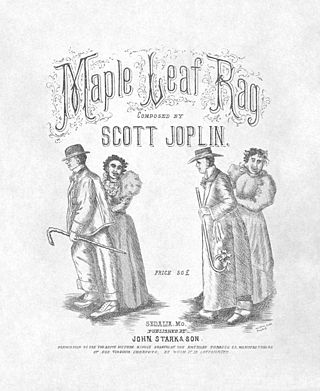
The "Maple Leaf Rag" is an early ragtime musical composition for piano composed by Scott Joplin. It was one of Joplin's early works, becoming the model for ragtime compositions by subsequent composers. It is one of the most famous of all ragtime pieces. Its success led to Joplin being dubbed the "King of Ragtime" by his contemporaries. The piece gave Joplin a steady if unspectacular income for the rest of his life.

Blues dancing is a family of historical dances that developed alongside and were danced to blues music, or the contemporary dances that are danced in that aesthetic. It has its roots in African-American dance, which itself is rooted in sub-Saharan African music traditions and the historical dances brought to the United States by European immigrants.
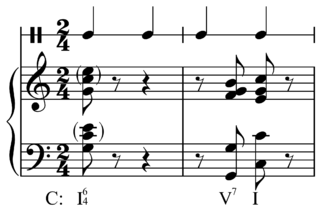
In tap dancing, jazz, and blues, stop-time is an accompaniment pattern interrupting, or stopping, the normal time and featuring regular accented attacks on the first beat of each or every other measure, alternating with silence or instrumental solos. Stop-time occasionally appears in ragtime music. The characteristics of stop-time are heavy accents, frequent rests, and a stereotyped cadential pattern. Stop-timing may create the impression that the tempo has changed, though it has not, as the soloist continues without accompaniment. Stop-time is common in African-American popular music including R&B, soul music, and led to the development of the break in hip hop.
Contradanza is the Spanish and Spanish-American version of the contradanse, which was an internationally popular style of music and dance in the 18th century, derived from the English country dance and adopted at the court of France. Contradanza was brought to America and there took on folkloric forms that still exist in Bolivia, Mexico, Venezuela, Colombia, Peru, Panama and Ecuador.

Treemonisha (1911) is an opera by American ragtime composer Scott Joplin. It is sometimes referred to as a "ragtime opera", though Joplin did not refer to it as such and it encompasses a wide range of musical styles. The music of Treemonisha includes an overture and prelude, along with various recitatives, choruses, small ensemble pieces, a ballet, and a few arias.

"Magnetic Rag" is a 1914 ragtime piano composition by American composer Scott Joplin. It is significant for being the last rag which Joplin published in his lifetime, three years before his death in 1917. It is also unique in form and in some of the musical techniques employed in the composition.
In music, the term swing has two main uses. Colloquially, it is used to describe the propulsive quality or "feel" of a rhythm, especially when the music prompts a visceral response such as foot-tapping or head-nodding. This sense can also be called "groove".
Stephanie Trick is an American stride, ragtime and jazz pianist.
References
- ↑ "Ry Cooder - Jazz - (Ry Cooder discography)". Rylanders.free-online.co.uk. Retrieved 6 November 2018.
- 1 2 Marshall Winslow Stearns, Jean Stearns. Jazz Dance: The Story of American Vernacular Dance , Da Capo Press, 1994, p. 21. ISBN 0-306-80553-7
- ↑ James Haskins with Kathleen Benson, Scott Joplin: The Man Who Made Ragtime , Doubleday and Company, 1978, pp. 105. ISBN 0-385-11155-X
- ↑ "Sun Flower Slow Drag, by S. Joplin (1868–1917)". Mutopiaproject.org. Retrieved 6 November 2018.
- ↑ "The watermelon trust; A slow drag". Library.duke.edu
- ↑ "A down home shout; Characteristic slow-drag two step". Library.duke.edu
- ↑ "Two Handed Stride - Judy Carmichael - Songs, Reviews, Credits - AllMusic". AllMusic. Retrieved 6 November 2018.
- ↑ "Ry Cooder - Jazz - (Ry Cooder discography)". www.rylanders.free-online.co.uk. Retrieved 2021-05-18.
- ↑ Stearns, Jazz Dance (1994), p. 24.
- ↑ John O. Perpener. African-American Concert Dance: The Harlem Renaissance and Beyond. University of Illinois Press, 2001, p. 37. ISBN 0-252-02675-6
- ↑ Stearns, Marshall; Stearns, Jean (22 March 1994). Jazz Dance: The Story of American Vernacular Dance. Hachette Books. ISBN 9780306805530. Archived from the original on 2012-11-12. Retrieved 2016-10-23.
- ↑ Stearns, Jazz Dance (1994), p. 23.
- ↑ Perpener, John (2001). African-American Concert Dance: The Harlem Renaissance and Beyond. University of Illinois Press. p. 37. ISBN 0252026756.
- ↑ Robinson, Danielle (2015-07-29). Modern Moves: Dancing Race during the Ragtime and Jazz Eras. Oxford University Press. ISBN 978-0-19-046604-6.
- ↑ John W. Roberts. Hucklebuck to Hip Hop. Odunde, Inc., 1995, pp. 63, 64. ISBN 1-885066-11-2
- ↑ Haskins and Benson, Scott Joplin (1978), p. 177.
- ↑ "Slow Drag". Bluesjazzclub.com. 1 September 2018. Retrieved November 25, 2023.
- ↑ Shawn and Joanna Trautman, Picture Yourself Dancing. Thomson Course Technology PTR. 2006, p. 62–63. ISBN 1-59863-246-9
